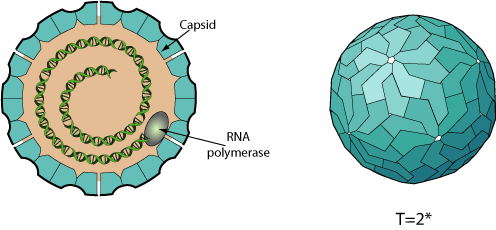Leishmaniavirus (taxid:39755)
VIRION

Non enveloped, icosahedral virion composed of a single capsid protein (CP), about 33 nm in diameter. The capsid has a T=2* icosahedral symmetry.
GENOME
Linear dsRNA genome of 5.3 kb. The genome has two large, overlapping ORFs on the positive strand respectively encoding CP and RdRp, and a small 5'-proximal potential ORF.
GENE EXPRESSION
The dsRNA genome is never completely uncoated, to prevent activation of antiviral state by the cell in response to dsRNA. The viral polymerase synthesizes a mRNA, which is translocated to the cell cytoplasm where it is translated.
Translation is initiated on a unique internal ribosome entry site (IRES) element situated at the 5'-UTR.
L-A virus seems to furnish its transcript with a cap structure derived from host mRNAs by cap snatching  .
m(7)Gp from the cap donor is transferred to the 5' end of the viral transcript, thus preserving the 5' α-and β-phosphates of the transcript in the triphosphate linkage of the final product.
The plus-strand viral transcript directs the translation of the major CP (Gag) and the minor fusion protein CP-RdRP (Gag-Pol) via a -1 ribosomal frameshift.
.
m(7)Gp from the cap donor is transferred to the 5' end of the viral transcript, thus preserving the 5' α-and β-phosphates of the transcript in the triphosphate linkage of the final product.
The plus-strand viral transcript directs the translation of the major CP (Gag) and the minor fusion protein CP-RdRP (Gag-Pol) via a -1 ribosomal frameshift.
ENZYMES
REPLICATION
CYTOPLASMIC
- Virus remains intracellular.
- Transcription of the dsRNA genome by viral polymerase occurs inside the virion, so that dsRNA is never exposed to the cytoplasm. This plus-strand transcript is used as template for translation.
- (+)RNAs are encapsidated in a sub-viral particle, in which they are transcribed to give RNA (-) molecules with which they become base-paired to produce dsRNA genomes.
- Mature virions may be transmitted to new cells during cell division.
Matching UniProtKB/Swiss-Prot entries
(all links/actions below point to uniprot.org website)3 entries grouped by strain
3 entries
Leishmania RNA virus 1 - 1 (isolate Leishmania guyanensis) (LRV-1-1) reference strain
Leishmania RNA virus 1 - 4 taxid:12530
| Protein | ModelArchive |
| Major capsid protein | ma-jd-viral-15397 |
| RNA-directed RNA polymerase (EC 2.7.7.48) | ma-jd-viral-19849 |
Leishmania RNA virus 2 - 1 taxid:39116
| Protein | ModelArchive |
| Major capsid protein | ma-jd-viral-15399 |
| RNA-directed RNA polymerase (EC 2.7.7.48) | ma-jd-viral-19838 |
Leishmania aethiopica RNA virus taxid:1497019
| Protein | ModelArchive |
| ORF3 | ma-jd-viral-15398 |
| Putative capsid protein | ma-jd-viral-15400 |
| RNA-directed RNA polymerase (EC 2.7.7.48) | ma-jd-viral-19839 |
